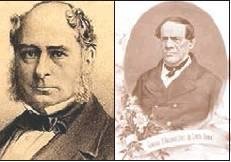Chewing gum’s sticky secret
HOLY COW! HISTORY
There is no Chewing Gum Hall of Fame. However, you can visit the next best thing: Joanne’s Gum Museum, located in a little building behind her house …
This item is available in full to subscribers.
Subscribe to continue reading. Already a subscriber? Sign in
Get 50% of all subscriptions for a limited time. Subscribe today.
Please log in to continueNeed an account?
|
Chewing gum’s sticky secret
HOLY COW! HISTORY
There is no Chewing Gum Hall of Fame. However, you can visit the next best thing: Joanne’s Gum Museum, located in a little building behind her house in Quartzsite, Arizona, featuring the collection of 4,000 pieces she has amassed since the 1940s.
The oldest known material that we would consider “gum” is 9,000 years old. Ancient Greeks chewed Mastiche, ancient Mayans chewed sap of the Sapodilla tree, Native Americans enjoyed chewing coagulated tree sap (and, just like us, probably growled expletives while they scraped it off their moccasins after stepping on it).
Leave it to an enterprising Yankee to take chewing gum to the next level (and make a buck off it, too). John Bacon Curtis cooked up some spruce gum sap over his kitchen stove in Bangor, and State of Maine Pure Spruce Gum hit the market in 1848. He initially peddled it in Portland.
Curtis eventually engaged his brother (some sources say it was his father, others say it was both the brother and the father) in the family business. They cooked the gum while he sold it all around New England. He followed the water and expanded his territory along the Ohio and Mississippi Rivers. In time, he was offering a rainbow of gum varieties: American Flag, Yankee Spruce, White Mountain, Licorice Lulu, Trunk Spruce, Four-in-Hand, Biggest and Best, and 200 Lump Spruce.
In 1850, he switched to a version that was somewhat like paraffin wax, and found customers liked it better. A whole lot better, in fact, because his company eventually occupied a three story factory, employed 200 people and turned out 1,800 boxes of chewing gum every day.
But John B. Curtis was a typically contrary Yankee and never took out a patent. He preferred to keep his gum and gum-making equipment secret. Which created a big controversy among historians: who was the first man to patent chewing gum?
Those who believe in hardcore accuracy point out a guy named Amos Tyler got one on July 27, 1869. But he never did anything with it.
Those with a more practical frame of mind note William Finley Semple received Patent # 98,304, the first truly commercial U.S. patent for chewing gum, on December 28, 1869.
While all this was going on, a photographer-turned-secretary-turned-inventor/scientist had a devil of a problem on his hands.
Thomas Adams was personal secretary to deposed Mexican dictator Generalissimo Santa Anna, who was living in exile on Staten Island, New York. (Yes, that Santa Anna, the bad guy of the Alamo story.)
Santa Anna had a crazy idea that he could import chicle, a gummy sap from a Mexican tree, and sell it as a cheap substitute for rubber. His enthusiasm was contagious, prompting Thomas Adams to buy a ton of the stuff.
Adams made chicle toys, chicle buggy tires, chicle masks, even chicle rain boots. None of them sold. The ex-dictator lost a bunch of money and the two parted company, leaving Adams with all that raw chicle on his hands.
He grew frustrated, and his chicle supply seemed destined to wind up getting dumped into the East River. Then one day, one of those serendipitous things that changes everything happened.
Adams was in a drug store and watched as a young girl bought a piece of paraffin wax chewing gum for a penny. Adams remembered something: when they were tinkering around in the laboratory, Santa Anna would often pop a piece of chicle in his mouth and chew it.
He rushed back to his lab and started over from scratch. Adams boiled some chicle and gave it a test chew. It was a vast improvement over the paraffin version (more elastic and longer lasting). He called his concoction Chiclets, and in February 1871 Adams New York Chewing Gum went on sale for a penny apiece.
Chewing gum as we know it had finally arrived. The late 1800s were boom times for gum makers; when they found they could add flavor to the stuff, sales really popped.
In 1891, a company opened in Chicago that produced baking soda. Sales were flat, so in 1892 the owner hit upon a promotion idea: he made chewing gum and attached one stick to each can. Suddenly, cans started flying off store shelves. Knowing a good thing when he saw it, the company owner stopped making baking soda and focused solely on producing gum. And he laughed all the way to the bank as a result. His name? William Wrigley. As in Wrigley’s Juicy Fruit (1893), Spearmint (1893), Doublemint (1914), Freedent (1975), Big Red (1975), Extra (1984), Winterfresh (1994), Orbit (2001) and Eclipse (2001) Chewing Gum. Yeah, that Wrigley.
Gum won’t be going away anytime soon. Americans consume 195 million pounds annually. That’s 300 sticks per person each year; almost one every day. Some parting trivia to ponder:
• Most chewing gum is sold between Halloween and Christmas
• Humans are the only animals that chew gum
• Chewing gum while peeling onions will keep you from crying.
Other items that may interest you










Comments
No comments on this item Please log in to comment by clicking here